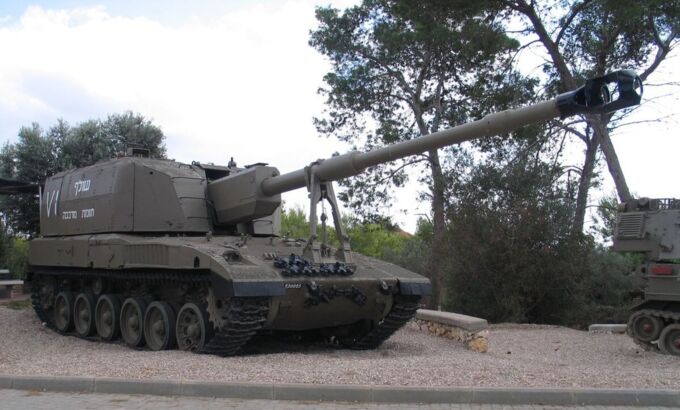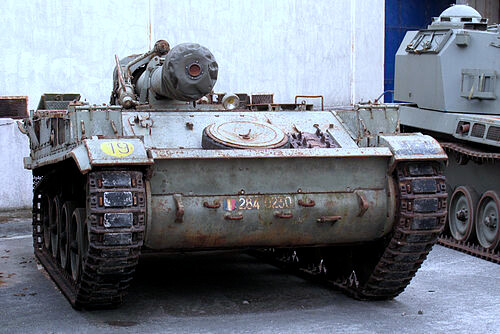The Sholef (שולף= “draw, scoot out” in Hebrew) was an Israeli experimental self-propelled artillery developed in the 1980s by Israel Military Industries (IMI) and Soltam. Considered one of the most advanced self-propelled artillery systems of its time, it never entered production and only 2 prototypes were ever created.
The story behind the Sholef
In the 1980s, a new SPG, named the “Sholef”, was designed and developed by Soltam Systems. While that project never reached serial production, the Sholef’s technology and development approach were adopted by German companies in creating the “PzH 2000” howitzer, now sold globally.
“The demand for the ‘Sholef’ came after the Yom Kippur War,” recounts Lt. Col. (res.) Rafi Almagor, who led the development branch for the Sholef under the Ground Forces Command. “At that time, there were only two battalions with the ‘Rochev’ SPG, the best we had. The rest were towed guns or barely mobile ones like the M-50.”
The need was clear: create a better-maneuvering SPG with higher fire rates, improved range, and better protection. After extended discussions, it was decided that the “Sholef” project would be based on the Merkava tank chassis and managed by the Tank Program Directorate at the Ministry of Defense.
The concept: develop a full artillery turret using an already available tank chassis. The Merkava’s front-engine design made it ideal. At the time, placing the engine at the front (like in the M-50) was revolutionary and enabled tank-to-SPG conversions. This sparked early thinking about a universal platform across IDF corps.
Why was it revolutionary + characteristics
The Sholef featured some impressive characteristics for the time, making it one of the best self-propelled artillery systems.
| Merkava Mk1 Chassis | The Sholef used a lengthened Merkava Mk1 with the same armor as the MBT, making the hull of the tank very resistant to enemy fire. |
| Teledyne Continental AVDS-1790-6A Engine | The Sholef featured the same engine as the Merkava, a Teledyne Continental V12 engine with over 900hp. This American engine can also be found on some variants of the M60. The engine was placed at the front of the vehicle. |
| Allison CD-850-6A / 6B | Same transmission as some variants of the M60 & M48 tanks, with two forward gears and one reverse gear. The transmission was in front of the engine. |
| 155 mm L/52 gun | This gun, developed by Soltam for the Sholef, was among the most advanced of its time.It had a long barrel, over 8 meters (26 feet), making it capable of reaching targets at a range of up to 40 km. It also featured a high-pressure chamber and a hydro-pneumatic recoil handling system. It had a semi-automatic breech (wedge block). |
| Auto-loader | The Sholef featured an electro-mechanic autoloading system developed by Soltam, a rare system for artillery at the time. The autoloader enabled a rate of fire of up to 9 rounds per minute for short bursts, or 6 rounds per minute during sustained fire. |
| Fire control system | The Sholef used a ballistic sight with a digital fire control system built by Tadiran. It used a combination of GPS and INS. |
| Ammo capability | The Sholef could carry up to 75 rounds in its automated loading system, with propulsion charges stored in fireproof containers. It could fire standard, EFB, BB, and RAP shells. |
| Survivability | The Sholef turret armor was able to withstand fire from up to 20mm AT rounds, while the chassis, inherited from the Merkava, could withstand fire from enemy tanks. It also featured automatic fire extinguishers and complete Nuclear, Biological, and Chemical (NBC) protection. |
| Crew | The Sholef had a crew of 4: the driver, the commander, the gunner and the loader |
Why did the Sholef never enter production?
The Sholef, while incredibly capable and powerful, never entered production for several reasons:
1: It was expensive
The Merkava chassis was of high quality. However, it came at a price of over 1.5 million USD (about 5 million with today’s inflation), bringing the Sholef’s cost to approximately 3.5 million USD. This was more than two times the price of an M109 artillery system, making it prohibitively expensive for mass production.
2: Not adapted to Israel war doctrine
The Israeli army was more focused on maintaining mobility, and the Sholef, with a weight exceeding 50 tons, was not particularly light or mobile, unlike the M109 “Doher”, a modernized version of the M109.
3: Limited international interest
4: They had better options
At the same time, Israel invested into the Doher (Rochev), a modernized M109, which proved much less expensive, lighter and almost as capable as a Sholef.
5: It was heavy
The Sholef, being over 50 tons, was difficult to transport and required specialized infrastructure, making it hard to operate in zones with little logistic support (like a desert).
The heritage of the Sholef
The autoloader, aiming systems and the FCS tested on the Sholef were integrated into future artillery designs.
By building the Sholef, Soltam gained the experience that helped them build the ATMOS-2000, their new truck-based SPG that was sold to 13 countries outside of Israel, and is planned to replace the old M109s of the Israeli army in a few years.




